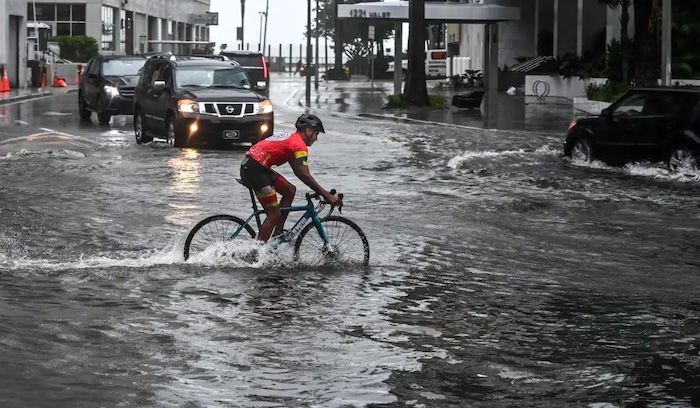Much of southwest Florida’s coast was in the dark as of early Thursday morning thanks to Hurricane Ian, which brought “catastrophic” flooding and prompted officials to prepare for a massive emergency response to the unusually powerful storm.
The US Border Patrol said that 20 migrants were missing after their boat capsized, but the US Coast Guard rescued three others and four Cubans made it to shore in the Florida Keys by swimming.
At around 3:00 p.m. (1900 GMT), the eye of the “very hazardous” hurricane reportedly made landfall on the barrier island of Cayo Costa, west of Fort Myers.
Television footage from Naples, Florida, revealed dramatic scenes of floodwaters rushing into beachside homes, covering roads, and washing away vehicles.
Fort Myers, Florida, is home to almost 80,000 people, and some of its neighborhoods look like little lakes.
Upon touchdown, the NHC reported that Ian’s maximum sustained winds had hit 150 mph (240 kph).
Florida was hit by storm surges, severe winds, and “life-threatening catastrophic floods,” the NHC reported at around 2:00 am local time on Wednesday, before weakening to a Category 1 hurricane with maximum winds of 75 miles per hour (0600 GMT).
Early Thursday morning, PowerOutage.us reported that over two million of Florida’s over eleven million customers were without power, with the southwestern part of the state being the hardest hit.
It is expected that many millions of people in Florida, Georgia, and South Carolina would be impacted by Hurricane Ian.
Forecasters predicted a once-in-a-generation disaster as hurricane conditions grew.
The director of the National Weather Service, Ken Graham, said, “This is going to be a storm we talk about for many years to come.”
Florida Governor Ron DeSantis predicted a “bad, awful day, two days” for his state.
Punta Gorda, a community north of Fort Myers, was left in near-total darkness when the hurricane knocked out power to all but a handful of businesses that had backup generators.
Tree limbs were torn from their trees, roof tiles were wrenched from their rafters, and palm tree fronds were blown horizontally by the strong winds.
About 2.5 million residents of a dozen coastal counties in Florida were ordered to evacuate, while others were encouraged to do so voluntarily.
Authorities urged people to stay home and burrow down if they were planning on weathering the storm.
All commercial flights were grounded at Tampa and Orlando airports, and cruise lines either postponed or canceled sailings.
Authorities in the Sunshine State issued grave warnings, predicting rainfall totals of up to 30 inches (76 cm) in certain areas, with a storm surge of up to eight feet (1.5 meters) in height.
Later on Thursday, the storm was expected to emerge in the Atlantic Ocean after passing through central Florida.
Hurricane Ian, which hit the western part of Cuba as a Category 3 storm and knocked out the island’s power grid, left the entire country in the dark a day before the start of the recovery and restoration effort.
According to official Cuban media, at least two persons have recently perished in the province of Pinar del Rio.
Havana and 11 other provinces had power restored by Wednesday, but the three worst-affected regions in western Cuba still did not.
The Pentagon reported that 3,200 members of the Florida National Guard had been activated, with an additional 1,800 expected to respond.
DeSantis stated that thousands of state and federal responders were being deployed to deal with the hurricane response.
A large number of Floridians will require assistance in rebuilding, he predicted.
The number of severe tropical storms, or cyclones, with higher wind speeds and heavier downpours is expected to rise as climate change warms the ocean surface.
While this may be true, the overall number of cyclones may not be.
North Carolina State University professor of atmospheric science Gary Lackmann claims that studies have found a possible link between climate change and rapid intensification, or when a relatively weak tropical storm surges to a Category 3 hurricane or higher in a 24-hour period, as happened with Ian.
Although fewer storms are expected overall, those that do occur will be more intense, according to Lackmann’s comments to AFP.
